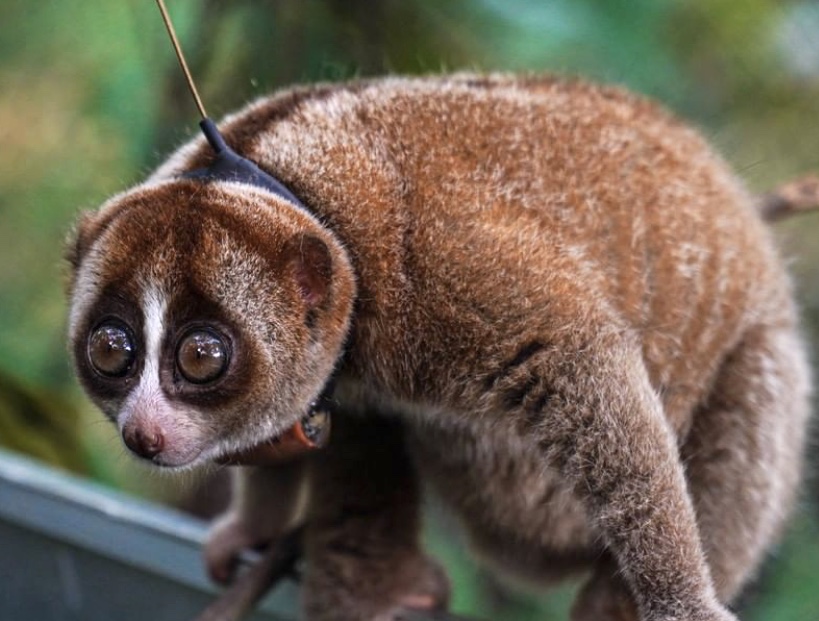Thirteen Slow Lorises Return To Their Home In The Sumatran Rainforest After Being Rehabilitated By International Animal Rescue
 Photo By: International Animal Rescue
Photo By: International Animal Rescue
Thirteen slow lorises have been returned to their home in Sumatra after undergoing rehabilitation at the specialist primate centre in Bogor, West Java. The lorises were released on March 16th in collaboration with the Centre for Natural Resources Conservation (BKSDA) for Bogor and Lampung.

Imam Arifin, a veterinarian from International Animal Rescue Indonesia said that the six male and seven female slow lorises had undergone rehabilitation to ensure that they were healthy and in good condition before returning to their natural habitat. After being kept under observation at the rehabilitation centre, it was confirmed that having completed all the stages of medical examination, quarantine, and behavioural recovery, they all met the release requirements.
“Those that are being released have undergone an intensive rehabilitation and recovery phase, starting with quarantine and medical examinations to ensure that they are not suffering from any diseases which they could transmit into their new habitat. In addition, their daily activity, diet, and habits have also been closely observed to ensure they are exhibiting wild behaviour,” Imam Arifin said in a statement.

Sumatra Slow Loris Release Coordinator, Bobby Muhidin, said that the release operation was carried out by a joint team from BKSDA Bogor and Lampung, the Forest Management Unit of Batutegi, as well as local volunteers. They transported the lorises in special cages as far as the habituation enclosure deep in the forest. “The habituation process enables the lorises to adapt to their new habitat before they are finally granted complete freedom,” Muhidin said.

Muhidin added that after the release of the lorises there is still a long process that must be carried out to ensure that they survive in the wild. Every day the team gathers data on the progress of the slow lorises in the habituation enclosure. If they display good natural behavior such as foraging, adapting to their new environment, and being able to survive, then they can finally be released.
After final release from the forest habituation enclosure, the lorises will be monitored for about six months to ensure that they are successfully fending for themselves. To facilitate monitoring, the lorises are first fitted with satellite collars. “The device functions as a signal sender and this is captured and makes a sound in the receiver. The sound that comes out of the receiver helps the monitoring team locate the lorises,” he explained.

Hifzon Zawahiri, Head of BSKDA Region III Lampung, welcomed the Sumatran loris release program. Sumatran lorises are increasingly threatened in their natural habitats due to the illegal pet trade and habitat destruction. Therefore, this program is highly beneficial to the survival of slow lorises.
He added that the rehabilitation program is lengthy and costly, appealing to the public not to buy and keep slow lorises as pets, because “In view of the economic principles of supply and demand, keeping slow lorises as pets supports hunting and the illegal pet trade. That means the hunt will continue as long as there is still demand for slow lorises, and that will only bring the slow loris closer to extinction,” he said.

Hifzon added that it was not an easy or quick process to return the slow lorises to the wild. A relatively long time and considerable effort must be devoted to giving them a second life. Generally, slow lorises that have been kept as pets and become accustomed to living with humans tend to experience changes in behavior and lose their wild nature. So they need more time to adjust before they can be released.
Ruchyansyah, The Head of the Forest Management Unit Batutegi said that the release of slow lorises and several other wild animals has been carried out before in the protected forest. He added: “We welcome this release program because it can increase the diversity of wildlife in the forest, particularly because the IAR Indonesia team also monitor the activities of released animals for some time to ensure that they are able to survive in the wild.

“However, we continue to encourage IAR to help us educate the surrounding communities so that they also play a role in preserving wildlife – and slow lorises in particular.”
Alan Knight, IAR’s Chief Executive added: “During the current global crisis, most of us are having to come to terms with restrictions on our day to day lives and our ability to move around freely. Imagine then the agony and frustration of being deprived of your freedom completely and being kept in a small space without access to adequate food and water. This is the fate of so many of the animals we rescue. That is why releasing them back into their natural habitat is always such a joyous and memorable occasion.”
Please consider donating to help International Animal Rescue continue their important work, HERE!
You can help all animals and our planet by choosing compassion on your plate and in your glass. #GoVeg
 Photo By: International Animal Rescue
Photo By: International Animal Rescue